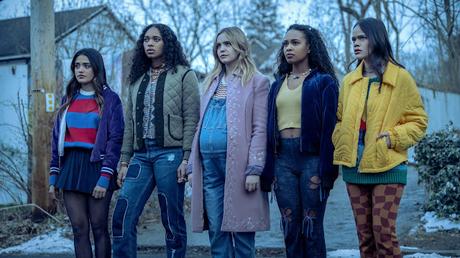
The original Pretty Little Liars, based on the books by Sara Shepard, ran from 2010 to 2017. On a recent rewatch, what struck me was that it was so easy to track changes in television landscape and pop-cultural discourse throughout the seasons – and from the perspective of 2024, the idea of having seven seasons of twenty-plus episodes already feels like an artifact of a bygone time. Pretty Little Liars, when it was good, was a revelation: an exercise in showcasing how young women are controlled (in the most literal interpretation of it, they find themselves trapped in a dollhouse), and not just by a hostile presence in their life (who mainly communicates through text messages), but by all the systems of authority around them – parents, cops, teachers. These authority figures are hapless at best, deliberately engaged in manipulation of and violence against them at their worst. All of this played out within the natural confines of a show that ran on the Disney-owned and conservative-leaning Family Channel (now Freeform). And when it was bad, it was terrible – the first season is dominated by a level of fat-shaming that feels deeply out of date now, the aftershocks of the horrors of the late 90s and early 2000s (although what Ozempic et al will wreak society now may just return us to these good old days), transphobic name-calling and worse, a super-villain who is revealed to be trans in later seasons, played by a cis actress. The show’s main queer character ends up with her former bully, and Aria Montgomery marries the teacher who has been grooming her since she was a teenager. What is presented as a happy ending comes across as much darker than was probably intended.
All of these conditions make the idea of a remake/sequel a mere five years later interesting, to say the least, especially transported to HBO Max (now just Max) and into the creative realm of Riverdale’s Roberto Aguirre-Sacasa, fresh off a show that seemingly had absolutely no limits in terms of how wacky it was allowed to be, which often translated into a fever-dream of a television show (there are plenty of listicles on its wildest storylines, and they truly are wild). Not only is Pretty Little Liars: Original Sin (Summer School in its second season, which arrives after a long break, perhaps in part due to the strikes last year) set in the same universe as the original show, there are also clues throughout that this is now happening in the same universe Riverdale (and therefore also the 2018 remake Chilling Adventures of Sabrina) was set in. All of these previous shows by Aguirre-Sacasa had a distinctive visual language that encompassed the worlds he was building, and Pretty Little Liars is no exception, but not unlike Sabrina, it’s even more interesting because it contrasts so perfectly with what the original show was: on the original PLL, set in the beautiful and affluent town of Rosewood, the darkness of the story was offset by the perfect surfaces of an upper-middle class context, where everyone had a refined wardrobe and even those who had had fallen on economic hardship had massive, beautifully furnished houses (Ashley Martin, Hanna’s mother, was always hustling the hardest to maintain the lifestyle, with her famous lasagna boxes of squirrelled-away money). The girls made frequent daytrips to Philadelphia, and even Emily, from more modest means than her friends, had a shiny Toyota Prius. In contrast, and maybe with full awareness that aspirational consumption doesn’t sell as well in an era of gritty television about teenagers, the new PLL is set in Millwood, Rosewood’s working-class and much less sparkling neighbor (think Pawnee vs Bloomington, but more), where the closest city is Pittsburgh. In the first season, everything is dark and gloomy: the houses feel stuffy, with lived-in furniture and indirect light sources that never seem to reach the corners. Everything, including the school, looks like it is in dire need of a fresh coat of paint if not major renovations. The other main settings, like the pizza parlour where everyone meets all the time (no fancy coffee shops here) and the cinema where one of the main characters work, feel like they have fallen out of time, have remained unchanged even if their patrons now have mobile phones. This sense of different economic circumstances extends to the new Liars: Pregnant Imogen (Bailee Madison), whose single mom tragically dies in the first episode (Carly Pope reappears frequently throughout after as an apparition, maybe in reference to the original Laura Palmer of the show, Alison DiLaurentis, but with less hope of returning from the dead), now lives with her best friend Tabby (Chandler Kinney). Imogen’s house, which Tabby’s mom is trying to sell, is heavily mortgaged, and even Tabby’s family is far removed from the splendour that fellow real estate agent Ashley Marin lived in. Faran’s (Zaria) mom is a lawyer, but the only visible sign of privilege here is that she takes ballet classes at her school (from a shockingly ableist and racist teacher), while her mom works in a cubicle in Pittsburgh. Minnie’s (Malia Pyles) mums have an antique shop in town that looks like it came straight out of the original show, creepy dolls and all. Noa’s (Maia Reficco) single mom is a nurse and struggling with an addiction to pain killers after a work injury, and Noa is wearing an ankle monitor and has to do community service at the beginning of the first season because she tried to protect her mum, who seems less than thankful – later on, Noa has to take over her mum’s shifts at the pizza store so she can detox.
Along with the existence of economic stress factors that deeply impact these teenagers (they seem to have jobs because they have to, not out of interest, while in the original show, only Emily ever had to consistently hold down a job during her high school years), the mechanism for throwing them in the path of a killer, again named A, is different. As drawn-out as the conspiracy around A was in the original show, at least for the first few seasons there was never any doubt that the original Liars had wronged them somehow (Mona x Hanna forever). Here, the “original sin” goes back to 1999, when all of their mums conspired to bully a girl ultimately into suicide, a death that prefaces the show and sets the tone a lot more darker and seriously than the original PLL started off as (it also reminded me of the way that Skins’ fourth season starts with a character dying the same way, and how the repercussions play out throughout the season – I wonder if that’s a coincidence). The five girls aren’t even friends to start off with, except Tabby and Imogen – their main connection is that they are struggling against Original Sin’s Alison DiLaurentis, who is still very much alive – Karen Beasley is a queen bee and mean girl, her twin sister Kelly like a paler shadow, and things really start escalating when one of them (it’s fairly easy to guess which, but the doubling and swapping is a great reference to both the original books and show, which loved playing with it, and probably also again a tie-in with Twin Peaks) falls from the rafters of the school trying to Carrie Imogen. The girls become friends over trying to solve what is happening to them, not unlike the unfortunately overlooked One Of Us Is Lying, which in its two very smart seasons (I always got the sense that it was much better than it had to be, and created with a lot of integrity and love) felt like a more ambitious and timely follow-up to the original PLL before Original Sin came out.
Whoever the killer is, he seems intent on avenging the 1999 death and appears to hate bullying, in general. It’s a solid mystery, connected to a dark family history (that tracks back to Rosewood’s iconic Radley Sanatorium, setting for many original mysteries but since closed and turned into a fancy hotel – Imogen and Tabby go on a field trip there and meet a recast Eddie Lamb). There’s body horror reminiscent of the original show, with dead bodies disappearing and reappearing and slasher movie influences (fittingly, since Tabby is such a horror movie fan). Where Original Sin truly succeeds is all the horrible things that are happening apart from the central mystery of the show: Karen’s dad is the local sheriff, a predator to young boys in his care and controlling and terrible to his daughters and wife. Imogen’s pregnancy is the result of a rape that she has kept quiet about because it is obvious that she can’t trust the system to help her, and later we find out that Tabby has gone through the same ordeal and is working on trying to find the culprit on her own, again because she has no faith (rightly so) that the local police would be any help. She is also avoiding the advances of her much older boss, who is trying to use their shared love of movies to seduce her (but is promptly called out for it, because luckily, Original Sin is not repeating the errors of the past). One of the few call-backs to the original show is Imogen’s intention to give her baby up for adoption to a “nice couple in Rosewood”, easily identifiable as Aria and Ezra, but she reverses her decision in the second season because of “weird vibes” she got off Ezra, a damning verdict on PLL’s greatest sin of never holding him accountable for his predation. A will eventually give each of the girls a chance to confront the worst person in their lives to test their ability for justice and forgiveness, but among them, one of the most complex and horrifying is Mouse’s: she’s never learned who her biological father is, and had a traumatic experience with almost getting kidnapped that her mothers refuse to be forthright about, so she is meeting a man whose daughter has disappeared by role-playing with him – something that initially feels more emotionally charged and difficult than you’d expect from the show, but quickly turns into a horror story as the man begins to stalk her (Mouse is also the youngest at fifteen). The true horrors here aren’t the ones related to the killer, just like the original shows had its secret big bads (dirty cops, Byron Montgomery’s obsession with controlling his daughter, Ezra, whatever that truly horrifying storyline of Alison’s pregnancy was). The other question underneath the surface of the show is the mums, the reformed bullies, who have caused so much emotional damage: is having grown and changed from the people they were as teenagers enough to be forgiven for their terror, or will it haunt them forever? Has Karen Beasley herself, in shedding off her skin and assuming that of her meek sister, successfully atoned? In the second season, summer has arrived in Millwood, and somehow Roberto Aguirre-Sacasa achieves a just as visually unsettling and alienating effect with direct light as he does in the first season with his poorly lit interiors: and the sun doesn’t last long, anyway (the retro cans of soda, perhaps relics from Riverdale’s final 1950s form, contribute to it), as the trials and tribulations continue.
2022-, created by Roberto Aguirre-Sacasa, Lindsay Calhoon Bring, starring Bailee Madison, Chandler Kinney, Zaria, Malia Pyles, Maia Reficco, Mallory Bechtell, Alex Aiono, Elias Kacavas, Sharon Leal, Jordan Gonzalez, Ben Cook, Travis Patton, Kate Jennings Grant, Lea Salonga, Gabriella Pizzolo, Derek Klena, Carlson Rowland, Elena Goode, Eric Johnson, Jennifer Ferrin, Kim Berrios Lin, Zakiya Young, Carly Pope.

